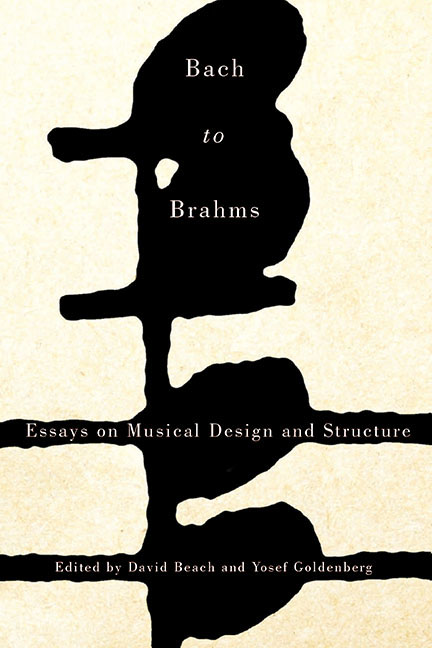Book contents
- Frontmatter
- Dedication
- Contents
- Introduction
- Part One Structure and Design
- Part Two Focus on Motive
- 5 Chopin as an Interpreter of Mozart: The Variations Opus 2 and Don Giovanni
- 6 The First Movement of Brahms's Fourth Symphony Revisited: A Study of the Fanfare and the “Cloud of Mystery”
- 7 “Capricious Play”: Veiled Cyclic Relations in Brahms's Ballades Op. 10 and Fantasies Op. 116
- 8 Chopin's Study in Syncopation
- 9 A Sharp Practice, A Natural Alternative: The Transition into the Recapitulation in the First Movement of Beethoven's “Hammerklavier” Sonata
- 10 Ernst Oster's Vision of Hidden Repetitions and Motivic Enlargements in J. S. Bach's Short Keyboard Works
- Part Three Structure and Design II
- List of Contributors
- Index
9 - A Sharp Practice, A Natural Alternative: The Transition into the Recapitulation in the First Movement of Beethoven's “Hammerklavier” Sonata
from Part Two - Focus on Motive
Published online by Cambridge University Press: 14 March 2018
- Frontmatter
- Dedication
- Contents
- Introduction
- Part One Structure and Design
- Part Two Focus on Motive
- 5 Chopin as an Interpreter of Mozart: The Variations Opus 2 and Don Giovanni
- 6 The First Movement of Brahms's Fourth Symphony Revisited: A Study of the Fanfare and the “Cloud of Mystery”
- 7 “Capricious Play”: Veiled Cyclic Relations in Brahms's Ballades Op. 10 and Fantasies Op. 116
- 8 Chopin's Study in Syncopation
- 9 A Sharp Practice, A Natural Alternative: The Transition into the Recapitulation in the First Movement of Beethoven's “Hammerklavier” Sonata
- 10 Ernst Oster's Vision of Hidden Repetitions and Motivic Enlargements in J. S. Bach's Short Keyboard Works
- Part Three Structure and Design II
- List of Contributors
- Index
Summary
Beethoven's Piano Sonata in B-flat, op. 106, was written in 1817–18, during a difficult time in the composer's life. This single sonata was the only major work that Beethoven wrote during the two-year period when he was preoccupied with a legal battle against his sister-in-law over the custody of his nephew. Its nickname “Hammerklavier” results from a spell of German nationalism that inspired Beethoven to substitute German expression markings for the usual Italian in all his works. Although the word “Hammerklavier,” the German for pianoforte, was also used for the Piano Sonata in A, op. 101, composed previously, it is only opus 106 that is known as the “Hammerklavier.” Beethoven was so delighted when he saw the proof of the title page that he wrote in high spirits to the publisher Artaria: “The title is good, and can be sent to Guttenbrunn, to Tahiti, Calcutta, Pondicherry, and, what is more, to Greenland and North America!”
The “Hammerklavier” is a daunting work, massive in scope, and stands apart from anything else Beethoven wrote. According to Charles Rosen, this sonata represents “an extreme point of his style. He never again wrote so obsessively concentrated a work. In part, it must have been an attempt to break out of the impasse in which he found himself.” Beethoven himself said that this sonata would give pianists something to do fifty years hence. Indeed, one of the most ardent champions of the work was the quintessential nineteenth-century Romantic pianist, Franz Liszt. The sheer scope of this sonata led Nietzsche to remark that the “Hammerklavier” was “an unsatisfactory piano arrangement of a symphony.” Taking up Nietzsche's suggestion that “a master of orchestration should waken to life for us that symphony,” the Austrian conductor Felix Weingartner made an orchestral transcription of the “Hammerklavier,” and recorded it with the Royal Philharmonic Orchestra in 1930. Despite the veneration that this monumental work demands, the “Hammerklavier” remains a forbidding work for many listeners, more often commanding respect rather than love. Nevertheless, its rewards are rich indeed; the exhilaration upon first hearing the “Hammerklavier” only deepens with closer familiarity with it.
Information
- Type
- Chapter
- Information
- Bach to BrahmsEssays on Musical Design and Structure, pp. 143 - 156Publisher: Boydell & BrewerPrint publication year: 2015
